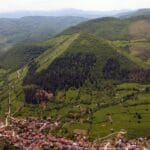Nestled in the heart of Visoko Valley, Bosnia and Herzegovina, lie a series of colossal structures that have ignited fierce debate and captivated global attention—the enigmatic Bosnian Pyramids. Are these imposing hills, as many scientists believe, merely natural formations sculpted over millennia? Or could they be, as some claim, the handiwork of an ancient civilization, predating even the Egyptian pyramids?
The Controversial Claims of Ancient Pyramids
Our journey into this archaeological enigma begins in 2005 when Bosnian-American businessman, Semir Osmanagić, boldly declared that the hills overlooking Visoko were not hills at all, but rather, the remnants of massive pyramids. Osmanagić identified five main hills as pyramids: The Pyramid of the Sun (Visočica hill), the Pyramid of the Moon, the Pyramid of Love, the Pyramid of the Dragon, and the Temple of Mother Earth. He suggested these structures could be the oldest and largest pyramids globally, predating the Egyptian pyramids.
Osmanagić’s claims hinge on several key points. He points to their seemingly precise geometric alignment with cardinal points, large blocks he identifies as man-made concrete, a network of underground tunnels, and reports of unexplained energy fields as evidence of their ancient, constructed origins. The site has since become a popular tourist destination, with Osmanagić claiming to have attracted 200,000 visitors in the first year alone, significantly boosting local tourism.
Scientific Consensus vs. Alternative Theories
Despite the public attention and tourism generated by Osmanagić’s claims, the scientific community, including archaeologists, geologists, and other experts, overwhelmingly refutes them.
Geologists argue that the “pyramids” are actually “flatirons,” triangular-shaped hills formed by the gradual process of erosion over countless years. What Osmanagić believes are precisely placed concrete blocks, scientists have identified as naturally occurring geological formations known as geopolymers.
These conclusions are further supported by the lack of credible archaeological evidence, such as ancient tools, pottery, or inscriptions typically found at legitimate archaeological sites, to corroborate the existence of ancient pyramids or any human construction for that matter. Seven leading European archaeologists publicly condemned the “Bosnian pyramids” as a “cruel hoax,” and the European Association of Archaeologists expressed concerns about potential damage to genuine archaeological and paleontological sites in Visoko caused by Osmanagić’s excavations.
However, despite the scientific consensus, alternative theories persist, often drawing upon pseudoscientific or esoteric beliefs about ancient civilizations, energy fields, and hidden history, further fueling public interest. This ongoing debate raises crucial ethical questions about the responsibility to preserve genuine archaeological sites, responsible tourism practices, and the dangers of misinformation spreading rapidly in our interconnected world.
Exploring Visoko: History Beyond the Pyramids
Putting the debate aside, it’s important to remember that Visoko itself is a place steeped in history, offering a captivating blend of tangible heritage and unsolved mysteries. Beyond the controversial pyramids, Visoko boasts a rich and undisputed history dating back to the Neolithic period (6000-2000 BC), with archaeological evidence of settlements, farming, and intricate pottery.
The region has witnessed the rise and fall of empires, each leaving an indelible mark on its cultural tapestry. Evidence suggests the presence of Illyrians, Celts, and Romans, with the latter leaving behind impressive infrastructure, including roads, cities, and even amphitheaters, some of which are still visible today. The Romans also introduced Christianity to the area, which would play a significant role in shaping Bosnian identity in the centuries to come.
The Middle Ages saw the emergence of Bosnia as an independent kingdom under the Kotromanić dynasty, known for their patronage of art, architecture, and the rise of the distinctive Bosnian Church. This era was followed by Ottoman rule in the 15th century, introducing Islam as the predominant religion and leaving behind architectural marvels like mosques and bridges that continue to inspire awe today.
In the 19th century, the Austro-Hungarian Empire brought about significant economic and societal changes, ushering in modernization and the development of railroads and education systems. Finally, after gaining independence in 1992, Bosnia and Herzegovina has faced challenges but emerged as a stable nation, its resilience reflecting the enduring spirit of its people.
Visiting the Bosnian Pyramids: A Journey of Discovery
Whether you’re drawn to Visoko by the mystery of the pyramids, the allure of its rich history, or simply a desire to explore off the beaten path, a journey to this intriguing corner of the world promises an unforgettable experience.
The pyramids are located near the town of Visoko, just a short 19 miles (30 km) drive northwest of Sarajevo. Getting there is easy, with regular buses from Sarajevo offering a convenient option. Once in Visoko, you can explore the site independently or opt for a guided tour for a more structured experience.
Key attractions include the Pyramid of the Sun, offering breathtaking panoramic views from its summit, and the Ravne Tunnels, a sprawling underground labyrinth said to possess a unique energy.
Conclusion
The Bosnian pyramids present a compelling enigma, challenging our understanding of history and the forces that shape our world. While the scientific community largely dismisses claims of ancient pyramids, the site’s enigmatic nature continues to draw visitors from far and wide, fueling tourism and igniting imaginations.
Whether you believe in their ancient origins or subscribe to the scientific explanation, the Bosnian pyramids offer a unique opportunity to ponder the mysteries of the past and the enduring power of belief. As you stand before these imposing structures, feel the weight of history and let your imagination soar amidst the breathtaking landscapes of Visoko, a place where ancient whispers mingle with modern wonder.
How to Visit the Bosnian Pyramids?
Ready to explore the Bosnian Pyramids? Here’s a quick guide:
- Location: The pyramids are in Visoko, about 19 miles (30 km) from Sarajevo. You can easily reach the site by car or bus.
- Guided Tours vs. Independent Exploration: Guided tours offer convenience and expert insights, while exploring independently allows for flexibility and a more personal experience.
- Must-See Attractions: Don’t miss the Bosnian Pyramid of the Sun, the tallest of the pyramids, and the Ravne Tunnels, an intriguing network of underground tunnels.
- Embrace the Debate: The mystery surrounding the pyramids’ origins is part of their allure. Keep an open mind and enjoy the various perspectives and theories.
- Immerse Yourself in History: Beyond the pyramids, Visoko offers a rich tapestry of history waiting to be discovered. Explore the town and learn about its fascinating past.
Remember, a trip to the Bosnian pyramids is a journey into the heart of an archaeological enigma, where history, mystery, and natural beauty intertwine.












